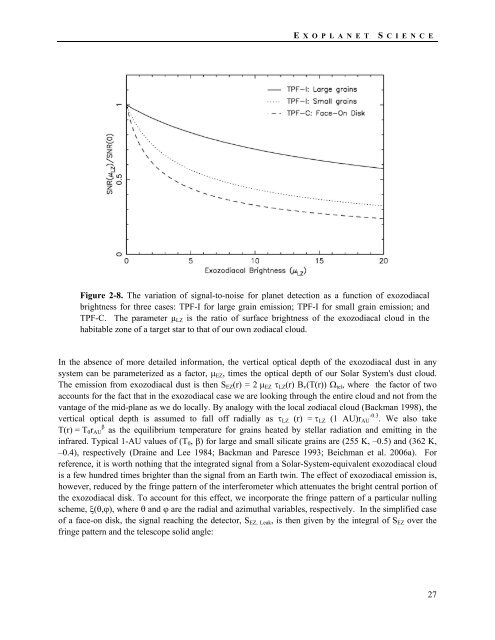TPF-I SWG Report - Exoplanet Exploration Program - NASA
TPF-I SWG Report - Exoplanet Exploration Program - NASA
TPF-I SWG Report - Exoplanet Exploration Program - NASA
Create successful ePaper yourself
Turn your PDF publications into a flip-book with our unique Google optimized e-Paper software.
E X O P L A N E T S CIENCE<br />
Figure 2-8. The variation of signal-to-noise for planet detection as a function of exozodiacal<br />
brightness for three cases: <strong>TPF</strong>-I for large grain emission; <strong>TPF</strong>-I for small grain emission; and<br />
<strong>TPF</strong>-C. The parameter μ LZ is the ratio of surface brightness of the exozodiacal cloud in the<br />
habitable zone of a target star to that of our own zodiacal cloud.<br />
In the absence of more detailed information, the vertical optical depth of the exozodiacal dust in any<br />
system can be parameterized as a factor, μ EZ , times the optical depth of our Solar System's dust cloud.<br />
The emission from exozodiacal dust is then S EZ (r) = 2 μ EZ τ LZ (r) B ν (T(r)) Ω tel , where the factor of two<br />
accounts for the fact that in the exozodiacal case we are looking through the entire cloud and not from the<br />
vantage of the mid-plane as we do locally. By analogy with the local zodiacal cloud (Backman 1998), the<br />
vertical optical depth is assumed to fall off radially as τ LZ (r) = τ LZ (1 AU)r AU -0.3 . We also take<br />
T(r) = T 0 r AU β as the equilibrium temperature for grains heated by stellar radiation and emitting in the<br />
infrared. Typical 1-AU values of (T 0 , β) for large and small silicate grains are (255 K, –0.5) and (362 K,<br />
–0.4), respectively (Draine and Lee 1984; Backman and Paresce 1993; Beichman et al. 2006a). For<br />
reference, it is worth nothing that the integrated signal from a Solar-System-equivalent exozodiacal cloud<br />
is a few hundred times brighter than the signal from an Earth twin. The effect of exozodiacal emission is,<br />
however, reduced by the fringe pattern of the interferometer which attenuates the bright central portion of<br />
the exozodiacal disk. To account for this effect, we incorporate the fringe pattern of a particular nulling<br />
scheme, ξ(θ,ϕ), where θ and ϕ are the radial and azimuthal variables, respectively. In the simplified case<br />
of a face-on disk, the signal reaching the detector, S EZ, Leak , is then given by the integral of S EZ over the<br />
fringe pattern and the telescope solid angle:<br />
27
















